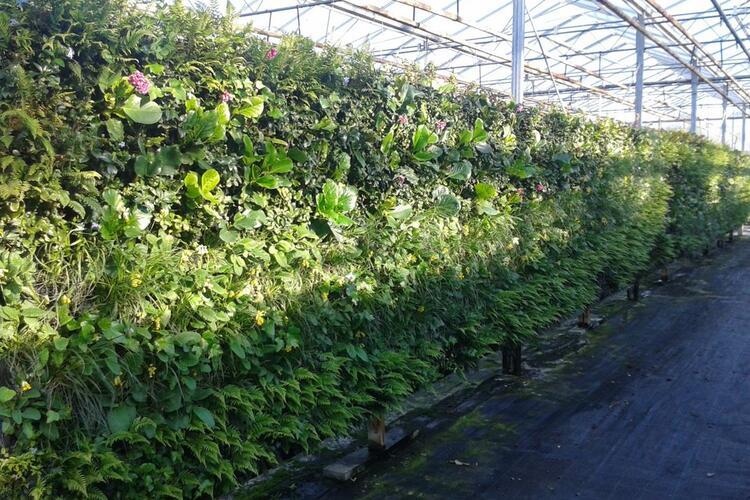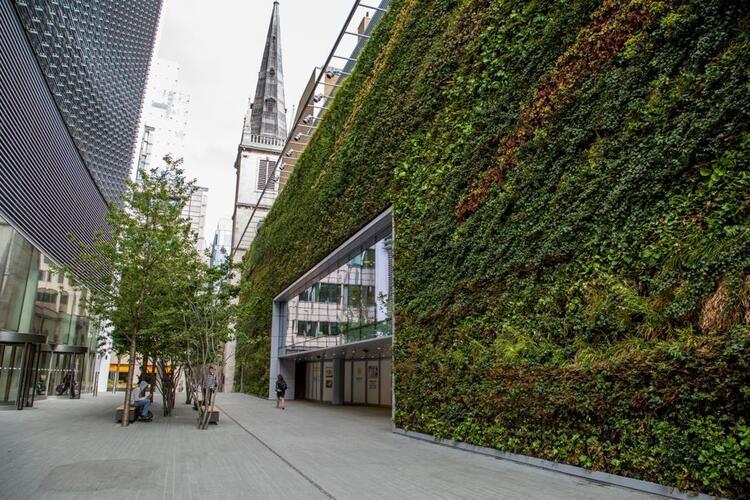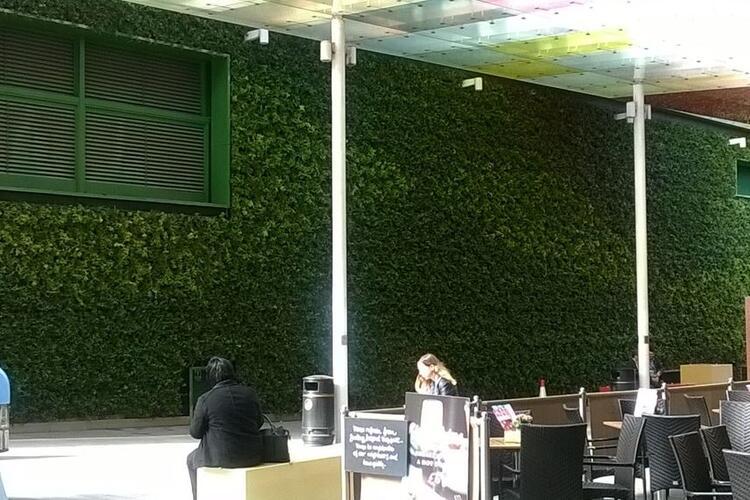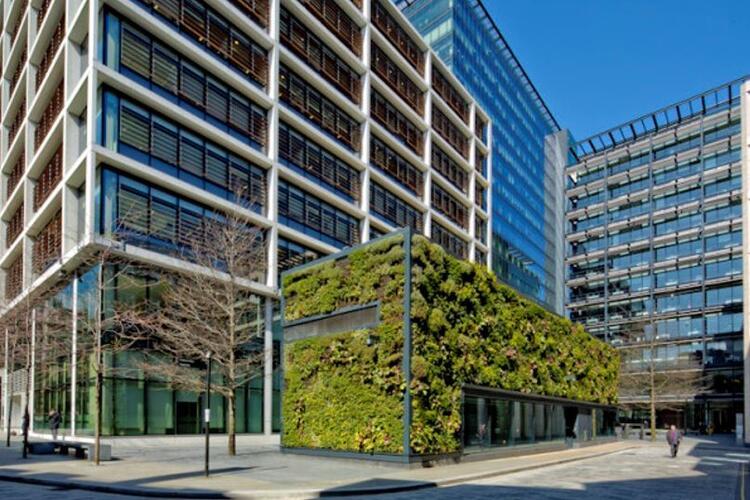Land Securities Creates Green Walls in Central London
18 January 2016Land Securities Creates Green Walls in Central London
18 January 2016Land Securities has created a series of flourishing green walls at its properties and developments in recent years, working with green wall specialist Biotecture. Green walls at New Street Square, 62 Buckingham Gate and 20 Fenchurch Street are improving the experience for office workers, shoppers and pedestrians, and providing important plant and insect ecosystems in the urban environment.
Key Facts
- 12,900 sq ft of green walls in central London
- One of the UK’s largest green walls at 20 Fenchurch Street
- Creating great spaces, attracting footfall and supporting wellbeing
- 85,000 plants, improving air quality and enhancing urban biodiversity
Situation
Land Securities is the largest commercial property company in the UK. The company is committed to maximising the biodiversity potential of all its developments and properties. Enhancements include green walls and roofs, ponds, window boxes, wildflower beds, bird and bat boxes, trees, hedgerows, beehives and insect hotels. In addition, for each tree cut down in the course of Land Securities’ development activities, the company plants another 100. More here.
Land Securities has been driving the installation of green walls across its central London portfolio. These differ from green façades, such as ivy walls, in that the plants root into a structural support and receive water and nutrients from within this vertical support, rather than from the ground.
Actions
At 20 Fenchurch Street, a joint venture development by Land Securities and Canary Wharf Group, the 7,600 sq ft green wall creates a pleasant and impressive environment surrounding the ground floor café area. The team included Biotecture, landscape architect Gillespies and landscape contractor Willerby Landscapes.
The green wall, located opposite the south face of 20 Fenchurch Street on an annex building, uses a hydroponic system, where plant roots grow in liquid nutrients largely without soil. The 52,000 plants include Evergreen Hart’s Tongue, red Heuchera ‘Marmalade’, small, densely leafed Lonicera Maygreen and long fronded Polystichum Setiferum. Flowering plants give bursts of colour and scent in the summer, with winter berries for year-round interest.
To start the growing process, pre-planted panels were fixed to a temporary wall in a nursery. Once established, panels were dispatched to 20 Fenchurch Street.
The base wall structure comprises recycled plastic boards fitted to a steel frame, overlaid with a thin drainage layer that allows excess irrigation water to drain out of the planting boxes and to the base of the wall. Each planted panel is open at the top and back, with an enclosed base. An irrigation drip line runs above each horizontal row of panels, with most water taken up by the plants and excess draining to the base of the panel and out to the rear. This eliminates excess water soaking into the panel below and subsequently over watering the lower sections. The green wall uses the same water storage tanks and control system as the ground floor landscaping but has its own irrigation scheme, monitored and controlled remotely.
At 62 Buckingham Gate, the 2,700 sq ft green wall improves the experience for pedestrians at ground level and livens up the old Westminster façade facing the new building. This supports Land Securities’ commercial strategy in Victoria of inspiring work environments and imaginative public realm.
The green wall, installed in 2015, features 15,000 plants that were carefully selected for the micro climate conditions, which include a coloured glass roof that affects light levels, and proactive maintenance is a priority for the team.
Green wall at 62 Buckingham Gate
At New Street Square, the 2,600 sq ft green wall envelopes the management suite, softening the transition from residential period properties to office buildings and creating attractive green space in this commercial district. This supports Land Securities’ strategy for New Street Square, creating the setting for events that add to the area's sense of vitality and community and increase footfall for retail and leisure customers.
Installed in 2011, the green wall design is a repeated matrix background with randomised clusters of plants for lush and natural greenery. The 18,000 plants include Evergreen Hart’s Tongue fern, native to the UK woodlands, and lavender, beloved of bees, hoverflies and people.
Flourishing green walls at New Street Square
Financials
- £50 per sq ft approximate installation cost and £2 - £10 per sq ft annual maintenance cost, depending on factors such as size, location, access, scope of works and plant types
- Property values near areas of urban greenery are known to be higher (Heidt and Neef 2008).
Benefits
Green walls can be installed in urban areas where there is limited space, bringing a range of social, environmental and commercial benefits.
Creating great spaces
- Enriching the built environment for customers and communities, for the thousands of people who walk past Land Securities’ flourishing green walls each weekday, relax or socialise in public spaces, or look out onto the greenery from their offices and homes; this can help office occupiers attract talent, increase footfall for retail occupiers and support wellbeing for building users
- Offering people opportunities to interact with nature in densely populated urban areas, fulfilling one of our strongest tendencies as human beings, our attraction to nature, Biophilia (Kellert et al 2008).
Supporting wellbeing and productivity
- Increasing productivity, e.g. call centre workers with better window views process calls 7-12% faster (California Energy Commission) and greenery in the built environment can improve wellbeing, reduce stress, and enhance comfort and performance (Kellert et al 2008)
- Improving air quality for occupiers and others, with plants catching and holding pollutants on the leaf surface, e.g. Lavendula Augustifolia in the green wall at New Street Square has a surface density capture for particulate matter to 10 microns (PM10) of 1.2g per m2
- Enhancing comfort levels for occupiers and others by reducing the urban heat island effect, as green walls shade buildings from the sun by up to 80% and do not re-emit heat back into the atmosphere at night (Ottelé 2011). This also reduces cooling demand and associated energy costs and carbon emissions.
Additional commercial benefits
- Supporting the planning process, with green spaces and infrastructure of increasing interest to planners and other regulators
- Delivering long-term cost savings by extending the life of the materials used in the building by protecting them from UV light, and potentially even reducing the amount of materials needed due to the insulating properties of green walls (Ottelé 2011)
- Creating opportunities for Land Securities to engage with customers and communities on biodiversity, as well as bringing reputational returns
- Contributing to Land Securities’ biodiversity goals and gaining BREEAM sustainability credits.
Enhancing urban biodiversity
- Creating habitats for plant and insect species, and foraging or nesting for birds, key to enhancing biodiversity in predominantly urban areas
- Acting as stepping-stones within a wider network of connected green spaces, allowing wildlife to move more freely and providing important refuges that can enable wildlife to survive in the urban environment.
Challenges and Achievements
DESIGN
How to design green wall systems that last?
When the original green wall was installed at New Street Square in 2008, there was little research or ongoing monitoring, and the robustness of the emerging systems was unproven. Not surprisingly, this first generation of green walls started to exhibit problems, mainly due to inadequate irrigation systems and a lack of control and monitoring of irrigation water movement within green walls. The wall was subsequently replaced in 2011. Understanding and technology have since moved on apace. The movement of water throughout the wall can be controlled and monitored remotely. Any interruptions in supply can be detected almost instantly, so issues can be rectified long before stress is placed on the plants. However, there are still issues for some green walls, often related to maintenance.
MAINTENANCE
How to maintain flourishing green walls?
Proactive maintenance of green walls is more effective and less expensive than reactive maintenance. With regular visual inspections and leaf sample checks, pruning around three times a year and remote monitoring, most perennial plants last for several years. All of this requires good access to the wall for maintenance, sometimes at short notice. This can be difficult in some locations, e.g. if irrigation systems are in the basements of buildings where access needs to be booked far in advance, or if green walls are in busy retail environments with extended opening hours. It is therefore important that maintenance is considered from the design stage, and that the property team, green wall specialist and developer all work together to ensure maintenance access can be gained on an ongoing basis, so action can be taken before plants become stressed.
PLANTING
How to choose the right plant species?
Planting needs to be carefully thought out from the beginning and the green wall team needs information about the micro climate and the client’s priorities early on. Micro climate considerations include light, e.g. the direction the wall is facing, shading and reflected light from nearby buildings, as well as wind loading and the urban heat island effect, which can result in warmer, longer summers in cities. Client priorities tend to include factors such as appearance, biodiversity, air quality and maintenance. Where biodiversity is a key focus, then more native species are likely to be planted, along with bee and butterfly friendly species. For maintenance, less manicured aesthetics usually require fewer visits, disease-resilient species last longer and drought tolerant plants consume less water. For air quality, species with ridged, hairy leaves tend to absorb more pollution than those with large, shiny leaves.
FINANCIAL
How to justify the cost where there is little direct financial return?
Whilst it is difficult to calculate a direct financial return from green walls, Land Securities is able to justify expenditure through planning and placemaking benefits. Planners in the City of London and Westminster City Council are always keen to see green infrastructure. The London Plan encourages the introduction of green surfaces to improve local air quality, promote biodiversity and mitigate the heat island effect. Green walls offer a way of delivering on these aspects, particularly where green roof potential is restricted by competition from plant, cleaning cradles and terrace areas. In addition, green walls create pleasant environments for Land Securities’ occupiers and others to enjoy, e.g. at New Street Square, 62 Buckingham Gate and 20 Fenchurch Street, the green walls frame and enhance seating areas in the public realm. Some green walls also contribute to BREEAM credits.
Photos © Biotecture
Find out more
Madeleine Velupillai
Environment Manager
Land Securities
www.landsecurities.com
*Please note that the information on this page was supplied by the BBP Member and the BBP assumes no responsibility or liability for any errors or omissions in the content




